by Alison Hugill // Sept. 22, 2021
In his multi-disciplinary practice, Berlin-based artist and composer Armin Lorenz Gerold turns traditional exhibition spaces into acoustic landscapes. For his recent two-day performance ‘Verstärkung (Amplification)’—commissioned by Halle für Kunst Steiermark in Graz—Gerold created a backdrop of ceramic vases containing colorful floral arrangements to adorn the speakers, in a collaboration with Barbara Urbanic. Collective making is a theme that runs throughout the project: Gerold has invited textual contributions from several artists and writers, reflecting on the many interpretations of “amplification,” which are read aloud by Enver Hadzijaj, Cornelia Herfurtner and himself, and screened on monitors mounted across the space.
The idea of amplifying certain voices has gained unprecedented traction during the pandemic, as solidarity initiatives for political groups have emerged in full force and the importance of ceding space to marginalized perspectives has become paramount. Gerold notes that, on social media in particular, these calls for amplification have too often been co-opted by corporate and institutional interests, but at their core remains an idea of reparation and a hope of healing a tendency toward silencing. We spoke to Gerold about ‘Verstärkung,’ his interest in the soundscapes of political demonstrations in his recent work and what unexpected opportunities social distancing measures have afforded his often performance-based practice.
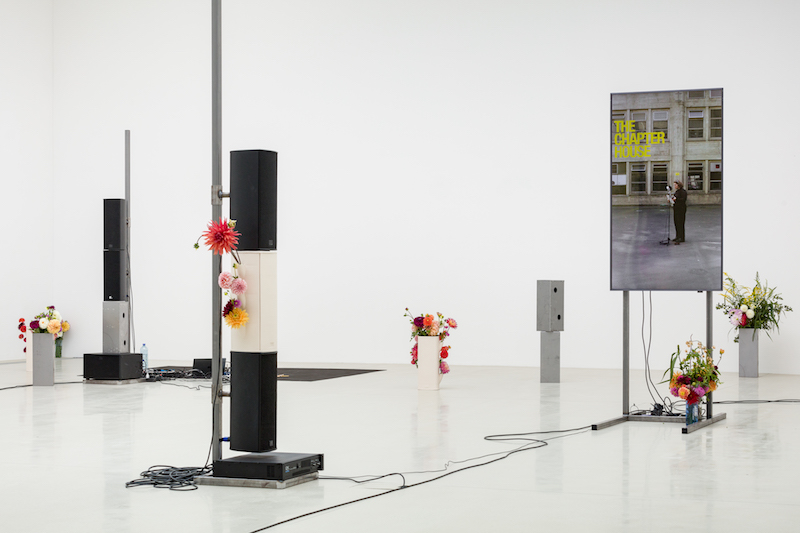
Armin Lorenz Gerold: ‘Verstärkung (Amplification), ‘ 2021, Installation view Halle für Kunst Steiermark, video and sound, ceramics, steel, flowers // Photo: kunst-dokumentation.com
Alison Hugill: Can you tell us about your recent performance ‘Verstärkung (Amplification)’ at Halle für Kunst Steiermark? What prompted you to explore the topic of “amplification” from a material and political point of view?
Armin Lorenz Gerold: The German word “Verstärkung,” contrary to the English translation, implies a connotation of solidarity I wanted to draw attention to. It can both be the amplification of an audio signal in sound but also a call for help or back-up. I’ve reached out to several artists and writers and invited them to contribute a text about amplification in the broadest sense. The feedback was amazing and I was lucky to have received text contributions by Alice Cannava, Alejandro Alonso Díaz, Jennifer Hope Davy, Enver Hadzijaj, Cornelia Herfurtner, Sinaida Michalskaja, Miriam Stoney and Bruno Zhu to work with. Some specifically produced a text for the occasion, others referred to something that had appeared in their individual research or practices before.
The term “amplification” more recently has been co-opted by (social) media and all sorts of institutions to express an attempt to change how stories are being told and also how these amplifications are connected to forms of power and their distribution. I left it pretty open to which aspects of the topic the artists could react, but I knew that the term would also resonate with them sonically. I wanted to create an installation that would host a broad soundscape in which those texts would appear in spoken form, read by me and artists Enver Hadzijaj and Cornelia Herfurtner, through which visitors could walk and find their own position.
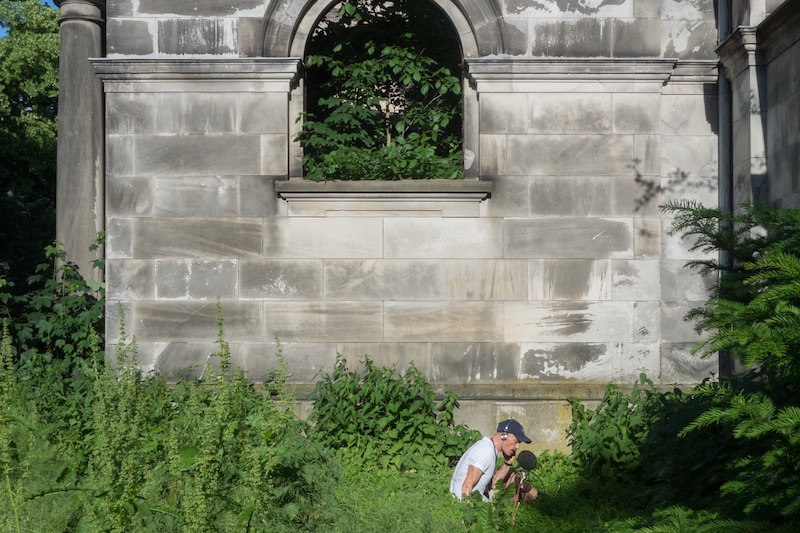
Armin Lorenz Gerold: ‘Untitled,’ 2021, Production Still // Photo: Armin Lorenz Gerold
AH: Do you see this work as enacting a kind of communal / communicative repair through the experience of live sound?
ALG: Among the many great texts in the installation, there is one from artist and writer Jennifer Hope Davy that specifically speaks about listening, tuning and detuning, in regards to the last year and the many events that shed light on inequality and the structural racism, colonialism and misogyny or sexism that precedes them. The text speaks about silencing and explores what listening could be, beyond the ways we were culturally or socially “tuned” or shaped to hear something or someone.
As an artist, it was important for me to create a different way of communicating rather than just presenting my “own” writing or voice, which is how I often worked before. The focus was on dialogue rather than just individual voices on their own.
I am so tired of people lamenting about the limitations of speech through political correctness and thereby (voluntarily or involuntarily) reproducing right wing agendas. I found it important at this moment to think about other systems or technologies of communication that aren’t just assertions of oneself but open up a dialogue and allow multiple voices and stories, as well as contrasts, at the same time. It’s not necessarily about me being a host for these voices or showcasing a network, but to figure out how such voicing could potentially sound.
AH: How do sculpture and sound connect in your work? Why is it important for you to give a physical form to the compositions you create?
ALG: It really depends on the project and the kind of sound (live/recorded). For my performance ‘Scaffold Eyes,’ which was presented at KW in Berlin, I installed semi-transparent curtains onto which I projected a video of a sunset recorded in an urban setting that faded towards darkness and eventually exposed me and my voice-actor sitting behind the curtain while live reading the play to the audience, a bit like in a shadow theater. It’s very important to me to explore how to connect to listeners but at the same time not to put too much emphasis on my own or my performers’ presence, so the audience has their individual space for listening.
In ‘Verstärkung’ I wanted to address the gap between sound as a mostly bodiless and invisible medium and connect it to something visual that the audience could investigate and focus on. I started this conversation with curator Cathrin Mayer, and on the other side with Barbara Urbanic, an experimental gardener and a historian of religions who made a floral installation with, and through, the various clay and metal replicas of the actual loudspeakers in the space.
My idea was from the beginning to stack the speakers and create towers with them, in reference to sound systems in general, which have historically been linked to protest culture or movements in the realm of subculture. There is, of course, also a phallic reference in this vertical architectural proposition. I was interested in exploring the discrepancy of a piece that is talking about a horizontal distribution of voice and solidarity through such a setting. As we, the listeners, engage with the sound, we are reminded that we are confronted with these “classic” forms or symbols of power, maybe even more so than ever.
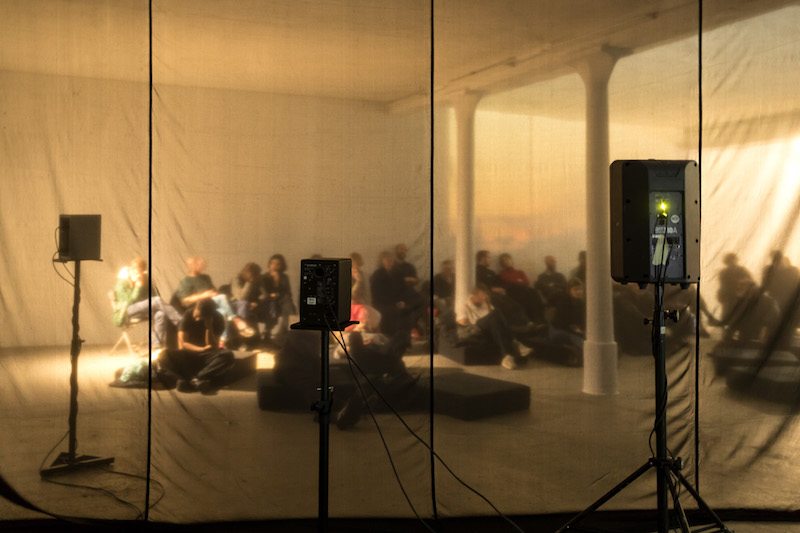
Armin Lorenz Gerold: ‘Scaffold Eyes,’ Performance, 2 November 2017, KW Institute for Contemporary Art, Berlin // Photo: Frank Sperling
AH: Can you talk about how you explore political and economic histories through your sound sculptures, such as the vases (Tulipieres) you and Barbara Urbanic created around the speakers in ‘Verstärkung’?
ALG: Barbara Urbanic brought up the Tulipieres as an object of wealth that showcased tulips as objects of financial speculation in 16th century Netherlands, which eventually led to an economic crisis in Europe. So they too speak to this idea of power I talked about before.
This reference was crucial in order to think about the vertical constructions of the installation. Barbara didn’t use tulips though, but worked with seasonal organic flowers from a farm nearby.
It’s the first time I specifically worked with sculpture. A ceramicist 3D printed the loud speaker vases, which look fragile and resilient at the same time. They were modeled after the Tulipiéres and had small openings on the sides to hold one to several flowers.
The sculptures are designed to give each listener the chance to explore a detail while they simultaneously have to navigate through the different sounds from the actual speakers including the sound of the readings from the videos. The monitor’s upright alignment almost made them look like oversized mobile phones.
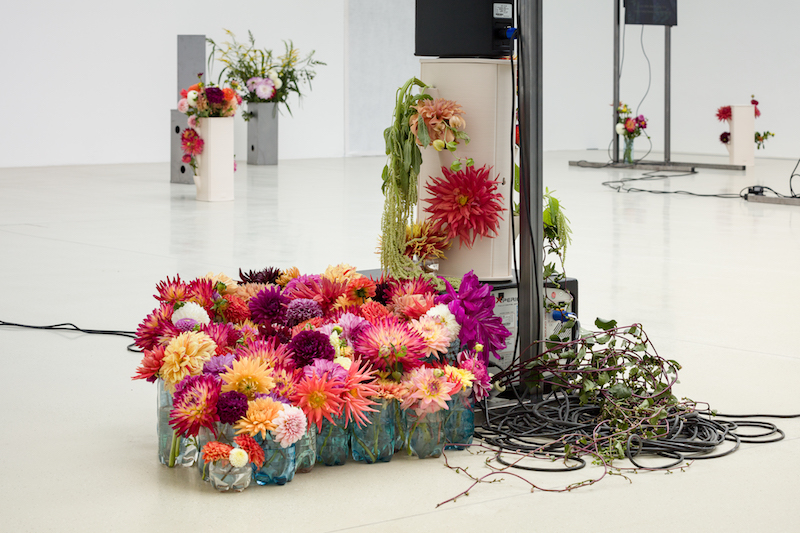
Armin Lorenz Gerold: ‘Verstärkung (Amplification), ‘ 2021, Installation view Halle für Kunst Steiermark, video and sound, ceramics, steel, flowers // Photo: kunst-dokumentation.com
AH: Tell us about your recent interest in the “sound of marching and demonstrating bodies.”
ALG: Sound cracks the imagination wide open. It was important to me to revisit the last year, sonically. Also, some important discussions that we had during the lockdowns seemed to have quickly passed. The first Black Lives Matter protest after the tragic death of George Floyd was the first real encounter I had with a mass of people after weeks of being isolated. It felt really intense to go from one to the other extreme and I’ve tried to examine how my body or my hearing reacted to that.
In preparation of ‘Verstärkung,’ I visited different protests in Berlin and eventually started to do field recordings of them. In the sound part of the installation, I compiled these recordings to an almost 10-minute segment because I wanted to invite people to “revisit” those places through sound. I did the editing on headphones, so it was only at the performance when I first heard the sounds loudly on the speaker towers in a multi-channel setting. Even while performing live, it was really moving to listen to amplified emotional speakers, crowds chanting and clapping, police warnings and helicopters. Knowing of course that in Graz, visitors might be more tentative to protest, in contrast to Berlin. I wanted to bridge that distance.
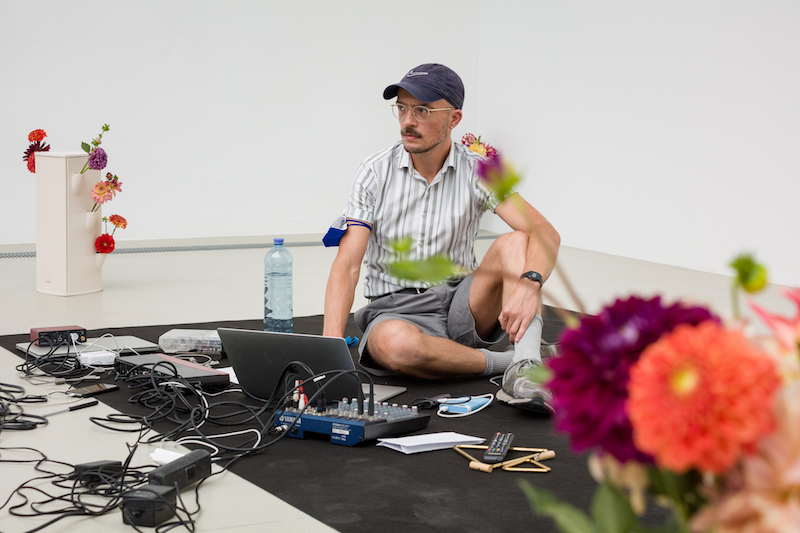
Armin Lorenz Gerold: ‘Verstärkung (Amplification),’ 2021, Performance // Photo: kunst-dokumentation.com
AH: How did you experience the last 1.5 years of pandemic restrictions in terms of your practice? How has it had to adapt to the supremacy of digital platforms and to what degree is live listening important to your work?
ALG: I’ve just released an artist book, which includes a new audio play ‘Manuel or A Hint of Evil’ and, among other texts, a conversation with composer Lori E. Allen about this contrast in depth. The pandemic has immediately stopped several projects I was working on and forced me to change trajectory. The book is among one of these projects and was initially conceived as an installation. I felt that, at least in the beginning of the pandemic, there was a moment that more or less forced each of us to reboot the ways through which we listen and speak with each other. Through a more interactive reading series on my IGTV, I’ve realised that I can work with these platforms and create stories through these media. But I’ve always worked with sound, radio plays and recorded music, so producing digital content was not new for me. Before and during the pandemic, I was so fortunate that several of my more pop-music sounds were featured on the LGBTIQ TV show ‘SKAM.’ The show exists as a regular TV show, but expands methods of storytelling in creating social media profiles for the fictional characters, altering the way viewers would normally engage with TV by lending these characters a “real” life in real-time. The pandemic enforced a kind of divide through digital platforms that was already happening. I don’t want to be melancholic and look back on being with crowds but I have to say that being with the audience in ‘Verstärkung,’ and all the contributors in the form of voices at the same time, was a very rewarding feeling.
I remember a performance by Phil Niblock at the electroacoustic Salon in Berghain about a year before the pandemic. He performed an extremely long drone piece. It was one of those performances that would make you lose your sense of time. I was fascinated by this approach, but equally disturbed because I’m always scared to overwhelm an audience’s attention span. Looking back on this one moment, it also became a reminder for me to try and stretch these limits more, too. Performance is such a short-lived but intense experience for both the artists and the audience, you might as well just sit through it together.
This article is part of our feature topic of ‘Repair.’ To read more from this topic, click here.
























